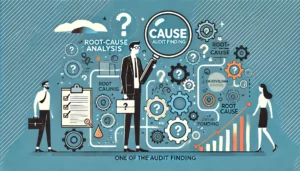What Are the 5 C’s of Audit Finding? A Quick Guide

Internal audits are crucial for ensuring that a company operates effectively and meets regulatory standards. The 5 C’s of audit findings are essential components that help auditors clearly communicate their observations and recommendations. Understanding these elements can help in identifying issues and implementing corrective actions.
Key Takeaways
- Criteria define the standards or benchmarks that the company should meet.
- Condition describes the current state of affairs, identifying any deviations from the criteria.
- Cause pinpoints the reasons behind the identified condition, explaining why the issue occurred.
- Consequence outlines the impact of the issue on the company, including potential risks and damages.
- Corrective Action details the steps that need to be taken to address the issue and prevent future occurrences.
1. What Are the 5 C’s of Audit Finding? Criteria
When we talk about audit findings, the first thing we need to consider is the criteria. This is all about the standards or controls that are in place or should be in place. Think of it as the benchmark we measure against.
Criteria help us understand what the expected conditions are. For example, in a PPC ecommerce agency, the criteria might include specific performance metrics for ad campaigns. These standards are essential because they set the stage for everything else in the audit process.
Why Criteria Matter
Criteria are crucial because they provide a clear picture of what should be happening. Without them, we wouldn’t know if something is off track. For instance, in an ecommerce PPC setting, criteria might include conversion rates, click-through rates, and return on ad spend.
Setting the Right Criteria
It’s important to set the right criteria from the start. This involves understanding the goals and objectives of the organisation. For example, a Google AdWords PPC campaign might have criteria related to keyword performance and ad quality scores.
Common Criteria in Audits
Here are some common criteria we might use in audits:
- Compliance with regulations
- Adherence to internal policies
- Achievement of performance targets
In a PPC ad agency, these criteria could include compliance with Google Ads policies and achieving specific client goals.
Criteria are the foundation of any audit. They help us determine if the current conditions meet the expected standards.
By setting clear criteria, we can ensure that our audits are both effective and meaningful. This is especially important for Google ads agencies and other organisations that rely heavily on performance metrics.
In summary, criteria are the benchmarks that guide our audit process. They help us understand what should be happening and provide a basis for comparison. Whether we’re auditing a London PPC agency or any other organisation, setting the right criteria is the first step towards a successful audit.
2. What Are the 5 C’s of Audit Finding? Condition
In an audit, the condition refers to the current state of affairs. It is crucial to clearly communicate and present this beforehand. We need to ask ourselves several questions to understand the condition fully:
- How does the identified issue relate to the company’s expected outcomes?
- Is there any policy that has been broken?
- Has the management team identified the condition that caused non-conformity or dissatisfaction?
- Does management believe that there is no issue? If yes, why?
- Which benchmarks have not been met?
Understanding the condition helps us see the gap between what is happening and what should be happening. This step is essential for a seamless shopping experience in our PPC audit process.
3. What Are the 5 C’s of Audit Finding? Cause
When we talk about the cause in an audit finding, we are essentially looking for the root cause of the issue. This is where we put on our detective hats and dig deep to understand why the problem occurred in the first place. Identifying the root cause is crucial because it helps us prevent the issue from happening again.
To determine the cause, we often conduct a root-cause analysis. This involves asking a series of questions to get to the bottom of the issue:
- What led to the problem?
- Who were the parties involved?
- Has the management team verified which processes were broken?
- What measures could have prevented this situation?
By answering these questions, we can pinpoint the exact reasons behind the issue. This step is vital because it allows us to take relevant actions against any identified flaws. It’s not just about fixing the problem at hand but also about ensuring that similar issues do not arise in the future.
Understanding the cause is like solving a mystery; it requires thorough investigation and analysis.
In summary, identifying the cause helps us understand the fundamental reasons behind each issue, allowing us to assign specific priorities and levels of urgency to each item. This systematic approach is essential for effective audit management and long-term improvement.
4. What Are the 5 C’s of Audit Finding? Consequence
When we talk about the consequence of an audit finding, we are referring to the impact or result of the identified issue. This is a crucial part of the audit process because it helps us understand the significance of the problem. Understanding the consequences allows us to gauge the severity and prioritise our actions accordingly.
To determine the consequences, we should ask ourselves a few key questions:
- What are the immediate and long-term effects of the issue?
- Are there any financial implications? If so, what are they?
- Does the issue affect any internal processes, or are there external consequences as well?
By answering these questions, we can better understand the full scope of the problem. This understanding is essential for developing effective corrective actions and ensuring that similar issues do not arise in the future.
It’s important to note that the consequences of an audit finding can vary widely, from minor inconveniences to significant financial losses or regulatory penalties. Therefore, a thorough analysis is necessary to fully grasp the impact.
In summary, identifying and understanding the consequences of an audit finding is a vital step in the audit process. It helps us to not only address the current issue but also to prevent future problems, thereby boosting the overall health of the organisation.
5. What Are the 5 C’s of Audit Finding? Corrective Action
When it comes to corrective action, we need to focus on how to fix the identified issues. This step is crucial for ensuring that the same problems do not occur again. Corrective actions are the steps we take to address the root causes of the issues found during the audit.
Steps to Implement Corrective Actions
- Identify Resources: Determine what resources are needed to implement the corrective actions. This could include personnel, technology, or additional funding.
- Develop a Plan: Create a detailed plan outlining the steps required to correct the issue. This plan should include timelines and responsibilities.
- Execute the Plan: Put the plan into action. Ensure that all team members understand their roles and responsibilities.
- Monitor Progress: Regularly check the progress of the corrective actions. Use monitoring techniques to ensure that the actions are being implemented as planned.
- Review and Update: Periodically review the effectiveness of the corrective actions. Make updates as necessary to address any new issues that arise.
It’s essential to have a structured approach to corrective actions. This ensures that we not only fix the current issues but also prevent future occurrences.
By following these steps, we can ensure a seamless and timely implementation of all corrective measures. This structured approach helps in maintaining the integrity of our processes and achieving our organisational goals.
In the realm of corrective actions, it’s crucial to address issues promptly and effectively. If you’re looking to enhance your PPC campaigns and drive better results, our team at PPC Geeks is here to help. We offer a free, comprehensive audit of your current ads to identify areas for improvement. Don’t miss out on this opportunity to optimise your advertising efforts.
Conclusion
Understanding the 5 C’s of audit findings—Criteria, Condition, Cause, Consequence, and Corrective Action—is essential for conducting thorough and effective audits. These elements help auditors identify issues, understand their origins, assess their impacts, and recommend solutions. By following this structured approach, organisations can ensure that their audits are not only comprehensive but also actionable, leading to continuous improvement and better governance. Remember, a well-conducted audit is a powerful tool for enhancing accountability and achieving organisational goals.
Frequently Asked Questions
What are the 5 C’s of audit finding?
The 5 C’s of audit finding are Criteria, Condition, Cause, Consequence, and Corrective Action. They help in structuring audit reports and ensuring all aspects of an issue are covered.
Why is Criteria important in an audit finding?
Criteria are the standards or benchmarks used to measure performance. They help auditors determine what should be happening in a process or system.
What does Condition refer to in an audit finding?
Condition describes the current state of the process or system being audited. It highlights what is actually happening, which may differ from the expected criteria.
How is Cause identified in an audit finding?
Cause is identified by looking at the reasons behind the condition. It involves understanding why the current state exists and what factors contributed to it.
What is the significance of Consequence in an audit finding?
Consequence outlines the impact of the condition. It explains the effects or risks associated with the current state, including any potential negative outcomes.
What is meant by Corrective Action in an audit finding?
Corrective Action refers to the steps that need to be taken to fix the identified issues. It includes recommendations for improvement and measures to prevent recurrence.
How do the 5 C’s improve audit reports?
The 5 C’s provide a structured approach to reporting, ensuring that all necessary details are covered. This makes the report clear, comprehensive, and useful for decision-making.
Can the 5 C’s be applied to different types of audits?
Yes, the 5 C’s can be applied to various types of audits, including financial, operational, and compliance audits. They are versatile and help standardise the audit process.
Author
Search Blog
Free PPC Audit
Subscribe to our Newsletter
The Voices of Our Success: Your Words, Our Pride
Don't just take our word for it. With over 100+ five-star reviews, we let our work-and our satisfied clients-speak for us.
"We have been working with PPC Geeks for around 6 months and have found Mark and the team to be very impressive. Having worked with a few companies in this and similar sectors, I rate PPC Geeks as the strongest I have come across. They have taken time to understand our business, our market and competitors and supported us to devise a strategy to generate business. I value the expertise Mark and his team provide and trust them to make the best recommendations for the long-term."
~ Just Go, Alasdair Anderson




